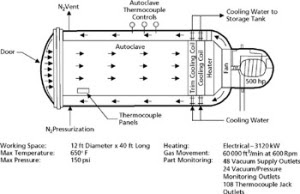Autoclaves
Autoclaves
Autoclaves for rubber product vulcanization are available a
wide range of sizes to suit the product type. The main use for autoclaves is in
the production of extrusions, sheeting and components which are of unsuitable
size of construction for convention mould vulcanization.Examples of this type of product can range from
roller coverings to hand-built products such as
footwear.
The Machinery:
Autoclaves are predominantly
cylindrical pressure vessels with lids or doors to process the rubber parts
that require exposure to elevated pressure and temperature. They are available
in a wide range of sizes and design pressures in horizontal (or sometimes
vertical) configuration.
The key component of the autoclave is the
door. For a manufacturer, this is also the critical component in
cost of autoclave construction.
Two types of autoclaves are in common use – Non-jacketed and Jacketed.
In the non-jacketed type, steam is introduced directly into the autoclave chamber. The steam condenses on the walls of your autoclave and on the surface of your rubber products under vulcanization. However, this leaves behind a mark on the surface of your product. And when you adopt preventive measures, you end up getting a dull finish on your rubber products. For some products like Radiator hoses for cars, you can cure in open steam.
The jacketed autoclaves has a double wall. Steam is circulated in the jacket to provide heating. There is no direct contact of steam with your rubber products. An inert gas (like Nitrogen) is then introduced in the autoclave to eliminate oxidation. Gases are normally poor conductors of heat and thus increases the curing time.
Steam curing is still the more widely used method and
involves the use of a gas or electric boiler supplying steam
to a
single-cased autoclave. Increasing
in popularity is the use of hot atmosphere curing in
autoclaves, where the internal pressurising medium (either air or nitrogen) is heated by
electric heater elements. This method has the
advantage of providing independent control of pressure
and temperature, unlike with steam, and
eliminating the detrimental effects
of condensation. Use of nitrogen also eliminates
surface deterioration of the product from oxidation.
An advantage of the autoclave for smaller components, is that a large
volume
of the same or different products can be vulcanised at the same time,
provided that the curative systems in use do not interact between the different
compounds. It is usual to support extrusions
and low hardness products in talc. Products
formed on mandrels
and sheeting, for example, are cloth wrapped to prevent distortion.
The temperature is raised using a number of steps to achieve uniformity of temperature
throughout the product
mass, before the final vulcanisation stage is reached.
It may be necessary to use a gas or steam circulatory system to ensure uniformity of temperature
throughout the whole of the autoclave and its contents.





Comments
Post a Comment